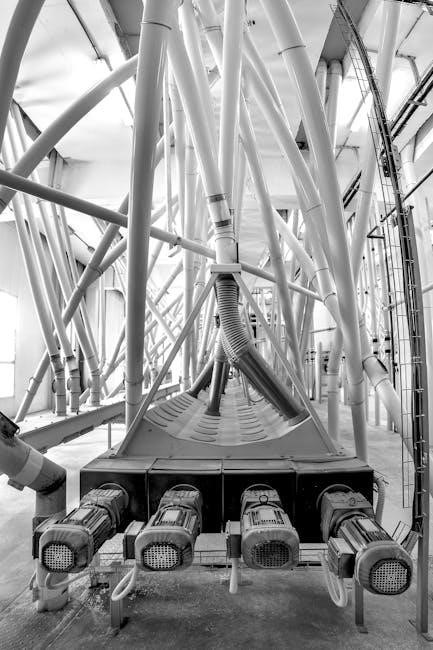Hydraulic fittings names are listed in a pdf document with detailed descriptions and sizes, including hose assemblies and fittings, using
standardized
naming conventions for easy identification always.
Overview of Hydraulic Fittings
Hydraulic fittings are crucial components in hydraulic systems, responsible for connecting hoses, pipes, and tubes to pumps, valves, and other equipment. The overview of hydraulic fittings provides a general understanding of their functions, types, and applications. Hydraulic fittings names pdf documents are available online, offering detailed information on various fittings, including their sizes, materials, and specifications. These documents are essential for engineers, technicians, and industry professionals who design, install, and maintain hydraulic systems. The overview of hydraulic fittings also covers the importance of proper fitting selection, installation, and maintenance to ensure the safe and efficient operation of hydraulic systems. By understanding the different types of hydraulic fittings and their applications, professionals can make informed decisions when selecting and installing fittings for their specific needs. This knowledge is critical in various industries, including manufacturing, construction, and aerospace.

Types of Hydraulic Fittings
Hydraulic fittings include
various
types such as adapters and connectors always used.
AN and MS Flared and Flareless Tube Fittings
AN and MS flared and flareless tube fittings are commonly used in hydraulic systems, with part numbers and descriptions listed in a pdf document for easy reference.
These fittings are designed to provide a secure connection between tubes and other components, and are available in a range of sizes and configurations.
The use of standardized naming conventions and part numbering systems makes it easier to identify and select the correct fittings for a particular application.
This helps to ensure that the hydraulic system is properly assembled and functions as intended, with minimal risk of leaks or other problems.
The pdf document provides detailed information on the different types of AN and MS flared and flareless tube fittings, including their specifications and applications.
By consulting this document, users can quickly and easily find the information they need to select and install the correct fittings for their hydraulic system.
This can help to save time and reduce the risk of errors, making it an essential resource for anyone working with hydraulic systems.
The document is regularly updated to reflect the latest developments and advancements in hydraulic fitting technology.
Hydraulic Hose Assemblies and Fittings
Hydraulic hose assemblies and fittings are critical components of hydraulic systems, and their names and descriptions are listed in a pdf document for easy reference.
These assemblies and fittings are designed to provide a secure and reliable connection between hoses and other components, and are available in a range of sizes and configurations.
The pdf document provides detailed information on the different types of hydraulic hose assemblies and fittings, including their specifications and applications.
It also includes information on the materials used to manufacture these components, such as rubber, steel, and aluminum.
The document is organized in a logical and easy-to-follow manner, making it simple for users to find the information they need.
By consulting this document, users can quickly and easily select the correct hydraulic hose assemblies and fittings for their application.
This can help to ensure that the hydraulic system is properly assembled and functions as intended, with minimal risk of leaks or other problems.
The pdf document is a valuable resource for anyone working with hydraulic systems, and is regularly updated to reflect the latest developments and advancements in hydraulic hose assembly and fitting technology.

Part Numbering Systems for Hydraulic Fittings
Part numbering systems for hydraulic fittings use codes and
formats
to identify specific fittings and sizes always correctly.
Examples of Part Numbers for Hydraulic Fittings
Examples of part numbers for hydraulic fittings are provided in a pdf document, including 100847, 100848, and 100854, which represent different types of fittings and hose assemblies.
The part numbers are used to identify specific fittings and sizes, making it easier to order and replace parts.
A list of part numbers is available, including 9000010284, 532644520143, and 9000012094, which correspond to various hydraulic fittings and hose assemblies.
Each part number is unique and provides information about the fitting or hose assembly, such as its size, material, and application.
The use of standardized part numbering systems ensures that hydraulic fittings and hose assemblies can be easily identified and replaced, reducing errors and downtime.
The pdf document provides a comprehensive list of part numbers for hydraulic fittings, making it a valuable resource for industries that rely on hydraulic systems.
The part numbers are organized in a hierarchical structure, with each level providing more specific information about the fitting or hose assembly.
This structure allows users to quickly locate the part number they need and order the corresponding fitting or hose assembly.
The examples of part numbers provided in the pdf document demonstrate the importance of standardized part numbering systems in the hydraulic industry.

Applications of Hydraulic Fittings
Hydraulic fittings are used in high pressure lines and blow out preventer systems, requiring
reliable
and durable connections always with specific names.
High Pressure Hydraulic Lines and Blow Out Preventer Systems
Hydraulic fittings play a crucial role in high pressure hydraulic lines and blow out preventer systems, where reliable and durable connections are essential.
The use of hydraulic fittings in these systems requires careful consideration of factors such as pressure, temperature, and flow rate.
In high pressure hydraulic lines, hydraulic fittings must be able to withstand extreme pressures and temperatures, while also providing a secure and leak-tight connection.
In blow out preventer systems, hydraulic fittings are used to control the flow of fluid and prevent blowouts, which can be catastrophic.
The selection of hydraulic fittings for these systems is critical, and must be based on a thorough understanding of the system requirements and the properties of the fittings.
Hydraulic fittings used in these systems include a range of standardized fittings, such as flanged fittings, threaded fittings, and welded fittings.
These fittings are designed to meet the specific needs of high pressure hydraulic lines and blow out preventer systems, and are subject to strict testing and inspection requirements.
Overall, the use of hydraulic fittings in high pressure hydraulic lines and blow out preventer systems is critical to ensuring the safe and reliable operation of these systems.

Product Names and Sizes of Hydraulic Fittings
Hydraulic fittings have specific product names and sizes, including DN and inch sizes, listed in a pdf document for easy reference and identification purposes always using tags.
Standardized Hose Types and Fittings
Standardized hose types and fittings are crucial in hydraulic systems, ensuring compatibility and safety. The use of standardized fittings, such as those listed in a pdf document, simplifies the process of selecting and installing hydraulic hoses.
Various organizations, including manufacturers and industry associations, have developed standards for hydraulic hose types and fittings, taking into account factors such as pressure, temperature, and fluid type.
These standards provide a framework for manufacturers to design and produce hydraulic hoses and fittings that meet specific requirements, making it easier for users to choose the right products for their applications.
The standardization of hose types and fittings also facilitates the exchange of products between different manufacturers, reducing the risk of compatibility issues and making it easier to find replacement parts.
Overall, the use of standardized hose types and fittings is essential for ensuring the safe and efficient operation of hydraulic systems, and the availability of standardized products makes it easier for users to design and maintain their systems.